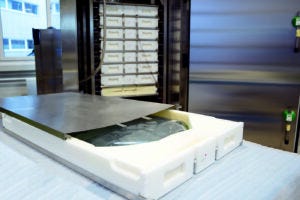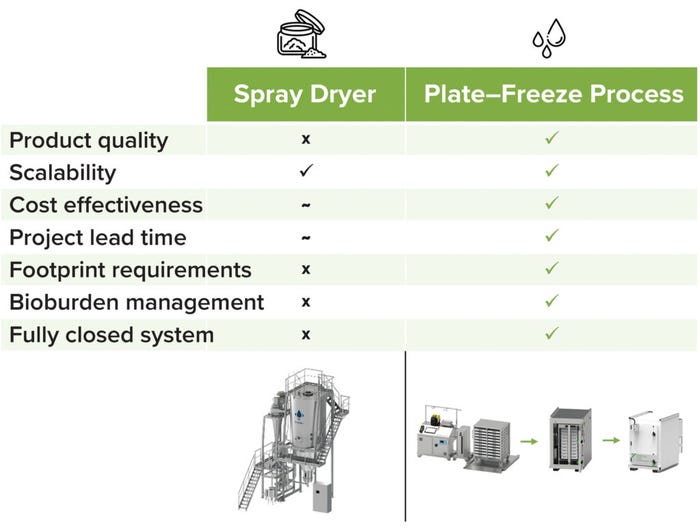- Sponsored Content
- Single Use
Dry To Die: Freezing Can Replace Spray Drying for Bulk IntermediatesDry To Die: Freezing Can Replace Spray Drying for Bulk Intermediates
June 26, 2023
Sponsored by Single Use Support

Photo 1: Single Use Support’s universally applicable RoSS.pFTU XL plate-based freezing platform.
Valuable bulk biopharmaceutical intermediates, such as bacterial or yeast cells for microbial fermentation or materials produced during a biomanufacturing process, often are transported to and from different manufacturing sites. During that transfer, maintaining product quality while minimizing degradation in desired properties is of utmost importance. It requires carefully controlled and reliable cold-chain logistics, which in turn rely on the equally carefully controlled process steps of freezing and thawing.
Spray drying is a widely used method for preserving microbial cells. However, some industry insiders point out that product losses often exceed 30% when such a process is applied to monoclonal antibodies (MAbs) or vaccines. An alternative is to freeze the liquids, but until now, freezing large volumes generally has been avoided because of technological limitations. Established equipment (e.g., static and blast freezers) require long freezing times, resulting in inefficient process solutions and high loss of product quality from the effects of cryoconcentration (1).
New end-to-end technologies for freezing, transport, and thawing of biopharmaceutical materials are here to advance the handling of pharmaceutical liquids. Plate-based freezing based on single-use systems brings improved product quality, lowered contamination risk, and reduced costs. Compared with spray drying and conventional freezing technologies, optimized end-to-end cold-chain management helps biomanufacturers significantly reduce product losses.
Spray-Drying Challenges
With spray drying, the mixture containing a compound of interest is atomized into hot air that rapidly evaporates the water, resulting in a dehydrated powder that can be stored or transported (2). The process is used commonly to make solid, particulate proteins for pharmaceutical applications (3), manufacture inhalable formulations for drug delivery (4), and produce vaccines that are more stable than those made using other methods (5). Bacterial or yeast cells often are spray-dried as an intermediate step in microbial fermentation processes. For the latter, spray drying is an attractive option because it is a relatively fast and scalable way to produce a fine powder with consistent particle size and good flowability. Bacterial or yeast cells thus preserved can be stored, transported, and further processed.
However, spray drying also is associated with significant loss of product quality. The high temperatures and pressures involved cause large shear forces (6) that lead to considerable process losses through denaturation and product aggregation (5). Product loss can be up to 30%, mainly attributable to particle deposition on the inner walls of a spray-drying chamber (6). Limited solubility makes it difficult to reconstitute and use spray-dried products, which are overall more prone to degradation over time.
Applying the method to complex, high-value products such as antibodies remains a challenge (5). Spray drying generally involves an open system, making it difficult to maintain the aseptic conditions that are crucial during biopharmaceutical production, and bioburden of spray-dried products thus can be considerable (6). In addition, spray-drying equipment requires a large footprint with extensive facility support in manufacturing facilities complying with good manufacturing practice (GMP) regulations. Overall costs are high for hardware and ongoing manufacturing requirements — e.g., maintenance, documentation, validation, and labor.
Plate-Based Freezer Technology
The rate of freezing has a major impact on the stability of proteins frozen in large quantities (7). However, it is difficult to control that rate with the conventional, static freezers available for this purpose. Therefore, biopharmaceutical companies increasingly turn to alternative, more controllable methods.
Plate-based freezing and thawing is one such method of freezing biopharmaceutical products. Plate freezers such as Single Use Support’s RoSS.pFTU system (Photo 1) ensure controlled and uniform freezing, helping to prevent valuable products from degrading during the process. Plate freezing is proven to be effective for controlled freezing of all types of biopharmaceuticals at laboratory scale and up to 1,000-L per batch. These plate-based freezers can be vendor agnostic when used in conjunction with Single Use Support’s RoSS secondary packaging solutions to store and transport frozen products safely in all commercially available single-use bags. In general, single-use bioprocess containers provide for safe liquid transfer in a closed system. The risk of biological contamination is therefore significantly lower than that of spray drying.
Controlled freezing refers to controlling both the ice-front growth speed and freeze rate (1). Single Use Support’s plate-based freezing system enables precise control of both crucial factors for completely homogenous freezing of materials — an essential requirement in freezing cell suspensions, for example (8). Controlling the ice-front growth speed minimizes the risk of cryoconcentration, a phenomenon that can cause product damage (1). With some products, a specific freezing rate is required to maximize the preservation of bioactivity. Plate freezing makes it possible to control the freezing of 100 L of product to a rate of ≤3 °C/minute. Technically, a freezing rate of 5 °C/minute is possible when small bags are used, but such a rate is too fast for most biological products. For example, a freezing rate of 1 °C/minute is recommended for cells — taking under two hours to go from +20 °C to –80 °C.
Advanced plate freezers are universally applicable. They are proven to be effective for freezing a number of biopharmaceutical products, including cells, mRNA, plasmid DNA, and bulk process intermediates, such as microbial cells for fermentation processes. Another important consideration is that plate freezing also facilitates scalability to commercial scales of hundreds of liters per batch.
Advanced single-use technologies facilitate highly effective filling, freezing, and shipping of large volumes of bulk materials embedded within a complete, end-to-end infrastructure. Depending on compliance with US Food and Drug Administration (FDA) 21 CFR part 11, the report and run data all can be collected and stored electronically. Uniquely, modular plate-based freeze–thaw platforms enable relatively rapid freezing of bulk intermediates and biopharmaceuticals, reducing the time needed for handling even large volumes and resulting in improved product quality.
Improved Manufacturing Efficiency
It is increasingly clear that spray drying is not the optimal method for preparing high-value and high-quality biopharmaceutical intermediates for preservation and transport. Product losses of up to 30% are simply unacceptable. Nevertheless, spray drying is widely used in the biopharmaceutical industry — mainly because there were no suitable alternatives for freezing and thawing.
Single Use Support’s novel, end-to-end process solution for filling, freezing, storing, transporting, thawing, and draining large volumes eliminates the need for spray drying of biopharmaceutical intermediates (Figure 1). The RoSS.pFTU XL system is game changing because it is the first plate-based freezer designed for controlled freezing of large volumes in a vendor-agnostic, modular, and scalable process for fluid and cold-chain management.

Figure 1: Compare spray drying with Single Use Support’s process solution for bulk intermediates.
References
1 Jenewein R, Breitrainer M. How Controlled Freezing Becomes Reality: Impact of Ice Front Growth Speed on Scalability of Freezing Protein Solutions. Single Use Support: Kufstein, Austria, 2022; https://www.susupport.com/knowledge/freeze-thaw/whitepaper-controlled-freezing-enables-scalability.
2 Bakry A, et al. Microencapsulation of Oils: A Comprehensive Review of Benefits, Techniques, and Applications. Compr. Rev. Food Sci. Food Saf. 15, 2015: 143–182; https://doi.org/10.1111/1541-4337.12179.
3 Emami F, et al. Drying Technologies for the Stability and Bioavailability of Biopharmaceuticals. Pharmaceutics 10(3) September 2018: 131; https://doi.org/10.3390/pharmaceutics10030131.
4 Li HY, Song X, Seville PC. The Use of Sodium Carboxymethylcellulose in the Preparation of Spray-Dried Proteins for Pulmonary Drug Delivery. Eur. J. Pharm. Sci. 40(1) 2010: 56–61; https://doi.org/10.1016/j.ejps.2010.02.007.
5 Ziaee A, et al. Spray Drying of Pharmaceuticals and Biopharmaceuticals: Critical Parameters and Experimental Process Optimization Approaches. Eur. J. Pharm. Sci. 127, January 2019: 300–318; https://doi.org/10.1016/j.ejps.2018.10.026.
6 Pinto JT, et al. Progress in Spray-Drying of Protein Pharmaceuticals: Literature Analysis of Trends in Formulation and Process Attributes. Dry. Technol. 39(11) 2021: 1415–1446; https://doi.org/10.1080/07373937.2021.1903032.
7 Minatovicz B, et al. Freeze-Concentration of Solutes During Bulk Freezing and Its Impact on Protein Stability. J. Drug Deliv. Sci. Technol. 58, 2020: 101703; https://doi.org/10.1016/j.jddst.2020.101703.
8 Wurm T. “Bestcellers”: Controlled Filling and Freezing of Cells. Bioprocess Online 22: https://www.bioprocessonline.com/doc/bestcellers-controlled-filling-freezing-of-cells-0001.
Daniel Tischler is director of commercial operations at Single Use Support GmbH, Endach 36, 6330 Kufstein, Austria; [email protected]; https://www.susupport.com.
You May Also Like






